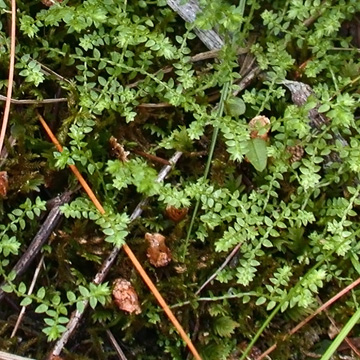

Selaginella apoda - (image 1 of 4)
Taxonomy
Family: Selaginellaceae
Only family in the order Selaginellales
Synonymous with S. eclipes Buck
Habitat
Meadows, stream banks; calcareous soils.
Associates
Distribution
Southern Quebec to WI, south to FL and TX.
Morphology
Terrestrial, evergreen herb; stems slender, subdichotomously branched, 0.2-0.4 mm thick, prostrate to ascending at the tips. Leaves delicate, sessile, 4-ranked, dimorphic; lateral leaves spreading, ovate, to 1 mm wide and 2 mm long, acute, obscurely ciliolate-dentate, not bristle-tipped; dorsal and ventral leaves appressed, about half as large as laterals, acute to long-acuminate. Cones 1-2 cm; sporophylls 4-ranked, slightly larger then the marginal leaves; megaspores white, 0.3-0.4 mm wide, the outer face reticulate.
Notes
Spores produced June to July
Wetland indicator: Facultative Wetland +
Selaginella spp. are vascular plants that superficially resemble mosses. They are one of two groups of seedless vascular plants (the other IsoŽtes spp.) that exhibit heterospory. Heterosporous plants produce spores of two types: smaller microspores that develop into male gametophytes, and larger megaspores that develop into female gametophytes. The development of heterospory was an important evolutionary step that led to the emergence of seed plants.
References
Gleason, Henry A. and A. Cronquist. 1991. Manual of Vascular Plants of Northeastern United States and Adjacent Canada. Second Ed.
The New York Botanical Garden. Bronx, NY
Swink, F. and G. Wilhelm. 1994. Plants of the Chicago Region.
Indiana Academy of Science. The Morton Arboretum. Lisle, Illinois.
|
Michael Hough © 2010 |